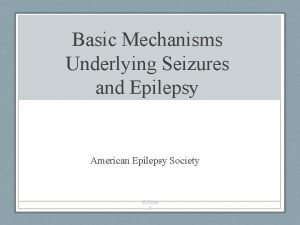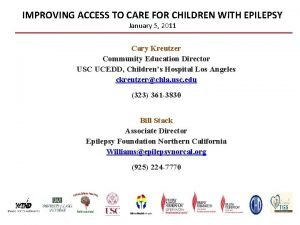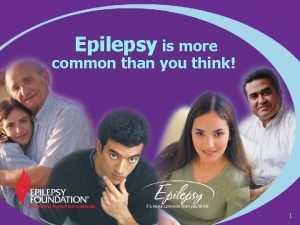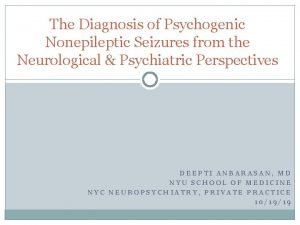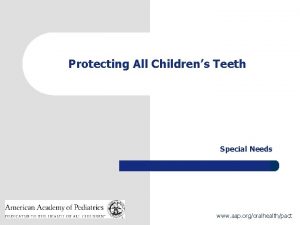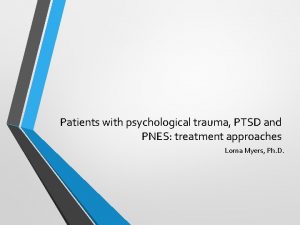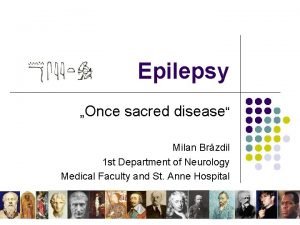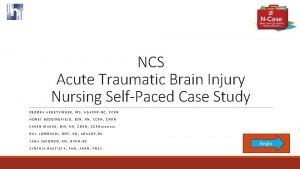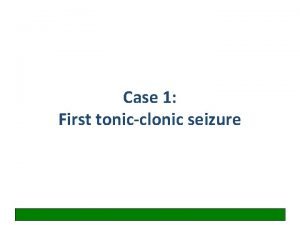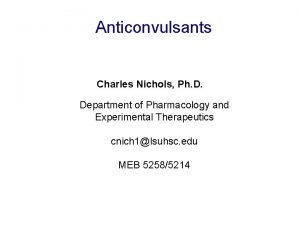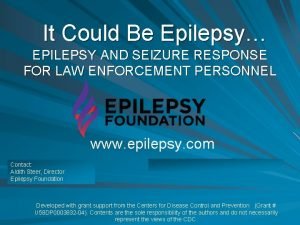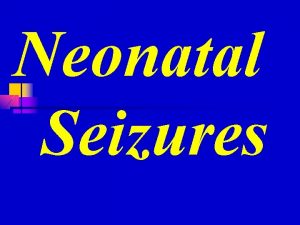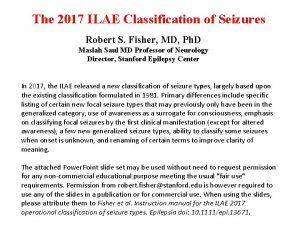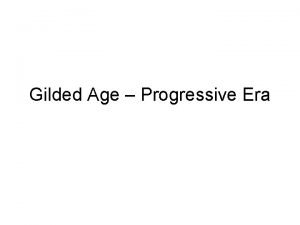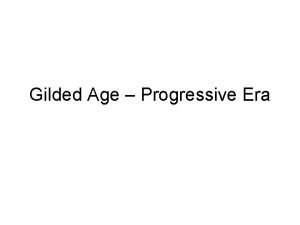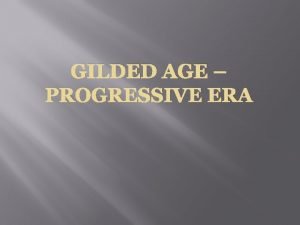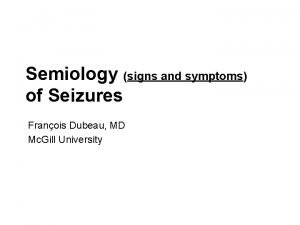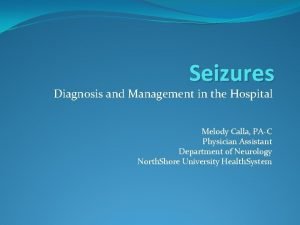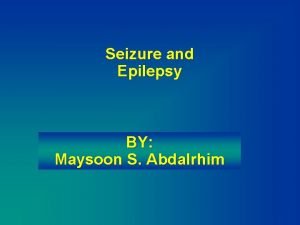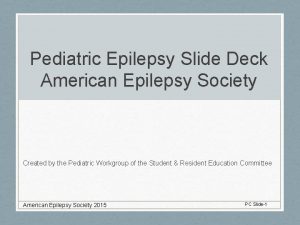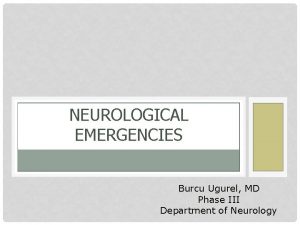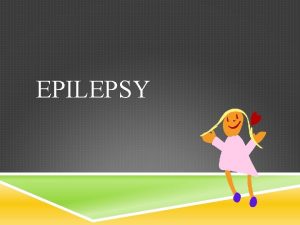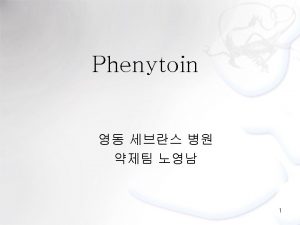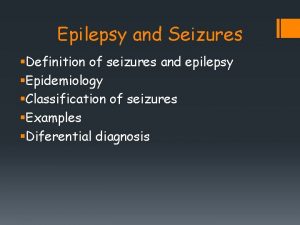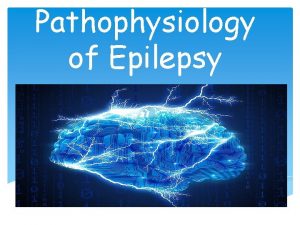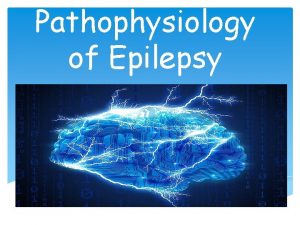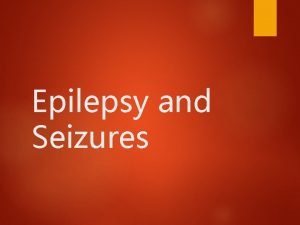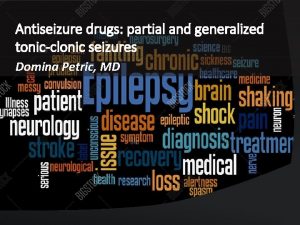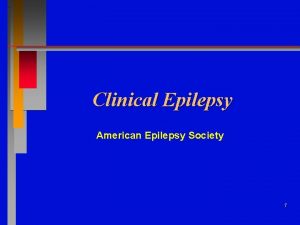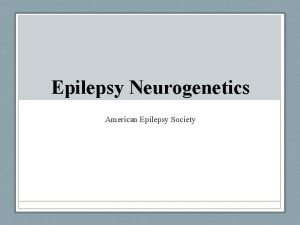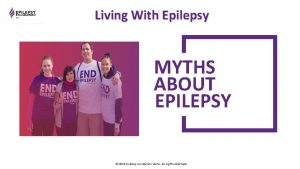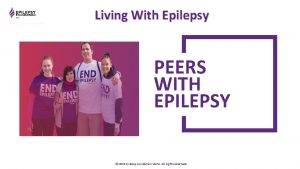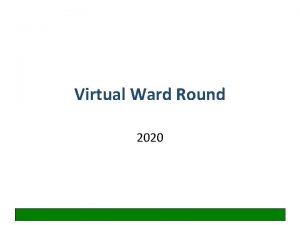Case 1 First tonicclonic seizure Seizures and epilepsy































- Slides: 31

Case 1: First tonic-clonic seizure

Seizures and epilepsy T-C seizure Due to acute illness Provoked Single unprovoked Part of epilepsy (? unrecognised) Generalised epilepsy Idiopathic Young people with normal brains Focal epilepsy Symptomatic Structural brain abnormality (not always demonstrable) Any age; elderly

4 key questions to ask • • Was this a seizure? Were there any obvious provoking factors? Is there evidence of unrecognised epilepsy? What is the patient’s job and driving status?


Summary of NICE guideline: general • All adults with a new suspected seizure should be screened first by a physician then referred to a specialist and seen within 2 weeks • Good communication, including written communication, is vital • A specialist is ‘a doctor with expertise and training in epilepsy’ • The diagnosis of epilepsy in adults should be established by a specialist • When NEAD is suspected, patients should be referred to psychology/psychiatry services • AED treatment needs to be tailored to type of seizures and type of patient • Women must be given information about contraception, pregnancy, breastfeeding etc. • All patients with epilepsy should have a regular structured review • If seizures are not controlled, or there is diagnostic uncertainty, patients should be referred to a specialist centre ‘soon’ for further assessment

Summary of NICE guideline: investigations • An EEG should be performed only in patients where the history suggests an epileptic seizure – EEG is not diagnostic and should not be used to ‘rule out’ epilepsy • An EEG should be performed ‘soon’ (within 4 weeks) • MRI is the imaging of choice in epilepsy and should be performed ‘soon’ • Imaging is not routinely required when a diagnosis of idiopathic generalised epilepsy has been made • CT can be used acutely to determine whether a seizure has been caused by an acute neurological problem • A 12 -lead ECG should be performed in all patients with suspected epilepsy • Serum prolactin measurement is not recommended • Epileptic seizures should be classified using a) a description of the seizure, b) seizure type, and c) aetiology or syndrome.

Summary of NICE guideline: treatment (brief summary for non-specialists) Focal seizures • Carbemazepine or Lamotrigine as first-line • Leveteracitam is not considered cost-effective (2011 analysis) • Leveteracitam, oxcarbazepine, sodium valproate second-line • Be aware of the teratogenic risks of sodium valproate • (Other drugs in refractory seizures should be prescribed by a tertiary epilepsy specialist) T-C seizures • Sodium valproate first-line • Be aware of the teratogenic risks of sodium valproate • Offer Lamotrigine if sodium valproate not suitable, but be aware this can exacerbate myoclonic seizures in JME • (Leveteracitam may be used for myoclonic seizures) • Lamotrigine, Leveteracitam, Topiramate second-line

Summary of NICE guideline: treatment (brief summary for non-specialists) When would you treat after a first tonic-clonic seizure? • • The person has a neurological deficit Brain imaging shows a structural abnormality The EEG shows unequivocal epileptic activity (? ) The person/carers consider the risk of having a further seizure unacceptable

Case 2: Single episode of prolonged vertigo

Single attack of prolonged vertigo: red flags • Focal neurological symptoms or signs at any time • Headache • Acute hearing loss • Abnormal eye movements not consistent with acute unilateral vestibular failure

Peripheral vs central nystagmus • Horizontal (with a torsional component) • Fast component away from the affected side • Does not change direction with direction of gaze • Inhibited by fixation • Fades after a few days • Vertical, horizontal or torsional • Fast component towards the affected side • May change direction with direction of gaze • Not inhibited by fixation • Lasts weeks or months

The HINTS examination https: //youtu. be/1 q-VTKPweuk

Case 4: Severe headache

Primary headache Migraine (and its many subtypes!) TTH TACS* e. g. cluster headache Other primary headaches e. g. 1 o cough 1 o thunderclap 1 o exercise Secondary headache Painful cranial neuropathies Head trauma Vascular e. g. ICH SAH Giant cell arteritis RVCS* Non-vascular e. g. intracranial hypertension intracranial hypotension Infection 5 other categories (not listed) e. g. TGN

Cluster headache Description: Attacks of severe, strictly unilateral pain which is orbital, supraorbital, temporal or in any combination of these sites, lasting 15– 180 minutes and occurring from once every other day to eight times a day. The pain is associated with ipsilateral conjunctival injection, lacrimation, nasal congestion, rhinorrhoea, forehead and facial sweating, miosis, ptosis and/or eyelid oedema, and/or with restlessness or agitation.

Treatment for cluster headache (NICE) • Acute treatment – Oxygen (>12 L RB) and nasal or SC tryptan – +/- metoclopramide or prochlorperazine – Do not use oral tryptans, paracetamol, NSAIDs opioids or ergots in acute cluster headache • Prophylactic treatment – Verapamil

Case 8: Fall due to dizziness

Facts n figures Diagnosis of vertigo in the Emergency Department (by neuro-otologists) Diagnosis % of cases BPPV Vestibular neuritis Migrainous vertigo Anxiety Stroke Pre-syncope 31 28 12 11 4 4 Cutfield NJ, Seemungal BM, Millington H, Bronstein AM. Diagnosis of acute vertigo in the Emergency Department. Emerg Med J 2011; 28: 538 -9

Simplified dizzy tree Lightheaded Postural 1 OH Vertigo Unrelated to posture 1 Uncompensated vestibular disorder 2 BPPV 3 MFDE 4 Neurological disorders 1 Cardiac 2 Anxiety or stress Single attack of prolonged vertigo 1 Vestibular neuritis 2 Stroke Disequilibrium Recurrent attacks 1 BPPV 2 Migraine 3 Meniere’s

Benign Paroxysmal Positional Vertigo • Affects almost 1: 10 older people, women twice as much as men • A range of symptoms: – Brief vertigo with certain head movements – Disequilibrium: ‘My balance is wrong. ’ – More prolonged dizziness can occur • A range of consequences: – Falls, fractures – Loss of independence • Very treatable! cochlea

BPPV: diagnosis and treatment • Patients have a normal neurological exam • They have delayed, rotatory, fatigueable nystagmus during the Dix-Hallpike maneouvre on the affected side • Don’t diagnose BPPV if the above criteria are not met • Treatment is the Epley maneouvre • Cure in 9/10 cases

Case 9: Transient speech disturbance

Diagnosis of TIA • Stroke symptoms and signs that resolve within 24 hours • Sudden, focal, neurological deficit • There are 4 key questions to consider: 1. 2. 3. 4. Was it sudden? (symptoms usually maximal at onset) Was it a focal neurological deficit? Has it resolved … completely? Was there impaired consciousness? • If the answer to 1 -3 is YES then TIA is likely. If the answer to 4 is YES then consider alternative diagnoses • If the patient is not completely back to normal when seen then treat as stroke

TIA/stroke checklist • • • R or L handed Driver BP Heart sounds Carotid bruits (if relevant) 12 -lead ECG/history of palpitations Cholesterol Glucose/Hb. A 1 c CRP/ESR Other …

Which arterial territory? Anterior (carotid) circulation Posterior circulation Cortical dysfunction (ie aphasia, sensory or visual inattention, hemianopia) Monocular blindness Unilateral weakness Unilateral sensory disturbance Dysarthria* Neuromuscular dysphagia* Cranial nerve palsy Ataxia/inco-ordination Diplopia Isolated homonymous hemianopia Bilateral visual loss Unilateral/bilateral weakness Unilateral/bilateral sensory disturbance Dysarthria* Neuromuscular dysphagia* *Less likely to be TIA/stroke if symptoms in isolation.

Case 10: Acute confusion

Transient global amnesia • Formerly thought to be related to migraine, TIA or epilepsy • Most likely caused by transient venous congestion leading to ischaemia in the hippocampus and other mesiotemporal brain structures associated with creating and storing memories • Caused by Valsalva-like maneouvres • Associated with physical exertion, swimming, sexual intercourse, use of marijuana and Viagra • Greatest risk factor is a history of migraines • Good prognosis, and small risk of recurrence

Transient global amnesia • • Patients are often wrongly described as ‘confused’ Abrupt onset of severe anterograde amnesia i. e. inability to form new memories Hence, often accompanied by repetitive questioning, and disorientated in time and place Everything else is preserved: memory relating to personal details, higher cortical functions, long term memory Retrograde amnesia often present (variable duration) Attacks last 1 -8 h Afterwards, rapid return of anterograde memory, with retrograde memory slower to return, most recent memories returning last

‘Seeing a healthy person become incapable of remembering what was said only a minute ago is very distressing, and hence it is often the relatives who require reassurance. ’ Harrison M & Williams M. The diagnosis and management of transient global amnesia in the Emergency Department. Emerg Med J 2007; 24(6): 444 -45.

Diagnostic criteria for TGA • • Attack was witnessed and reported Obvious anterograde amnesia during the attack No clouding of consciousness No focal neurological symptoms or signs No features of epilepsy Attack resolved within 24 h No recent head injury or active epilepsy Hodge & Warlow, 1990

What three things have you learned this morning?
 Basic mechanisms underlying seizures and epilepsy
Basic mechanisms underlying seizures and epilepsy Seizure
Seizure Epilepsy and seizure services near sutter creek
Epilepsy and seizure services near sutter creek Difference between seizure and epilepsy
Difference between seizure and epilepsy Tremors vs seizures
Tremors vs seizures Psychogenic seizures
Psychogenic seizures Pediatric seizures
Pediatric seizures Ptsd seizures
Ptsd seizures Psychomotor seizures
Psychomotor seizures Psychomotor seizures
Psychomotor seizures Subclinical seizures eeg
Subclinical seizures eeg Health education for meningitis slideshare
Health education for meningitis slideshare Seizures
Seizures Tonic-clonic seizures
Tonic-clonic seizures Epilepsy
Epilepsy Atypical febrile seizure
Atypical febrile seizure Simple partial seizures vs complex
Simple partial seizures vs complex Simple partial seizures vs complex
Simple partial seizures vs complex Best worst and average case
Best worst and average case Jitteriness and seizure
Jitteriness and seizure Seizure types and symptoms
Seizure types and symptoms A mob's illegal seizure and execution of a person.
A mob's illegal seizure and execution of a person. What ended reconstruction
What ended reconstruction A mob's illegal seizure and execution of a person
A mob's illegal seizure and execution of a person Seizure precautions nursing
Seizure precautions nursing Ictal phase
Ictal phase Seizure vs syncope
Seizure vs syncope Seizure precautions bed rails
Seizure precautions bed rails Hypsarrhythmia eeg
Hypsarrhythmia eeg Breakthrough seizure
Breakthrough seizure Warning signs of a seizure
Warning signs of a seizure Seizure precautions bed rails
Seizure precautions bed rails
